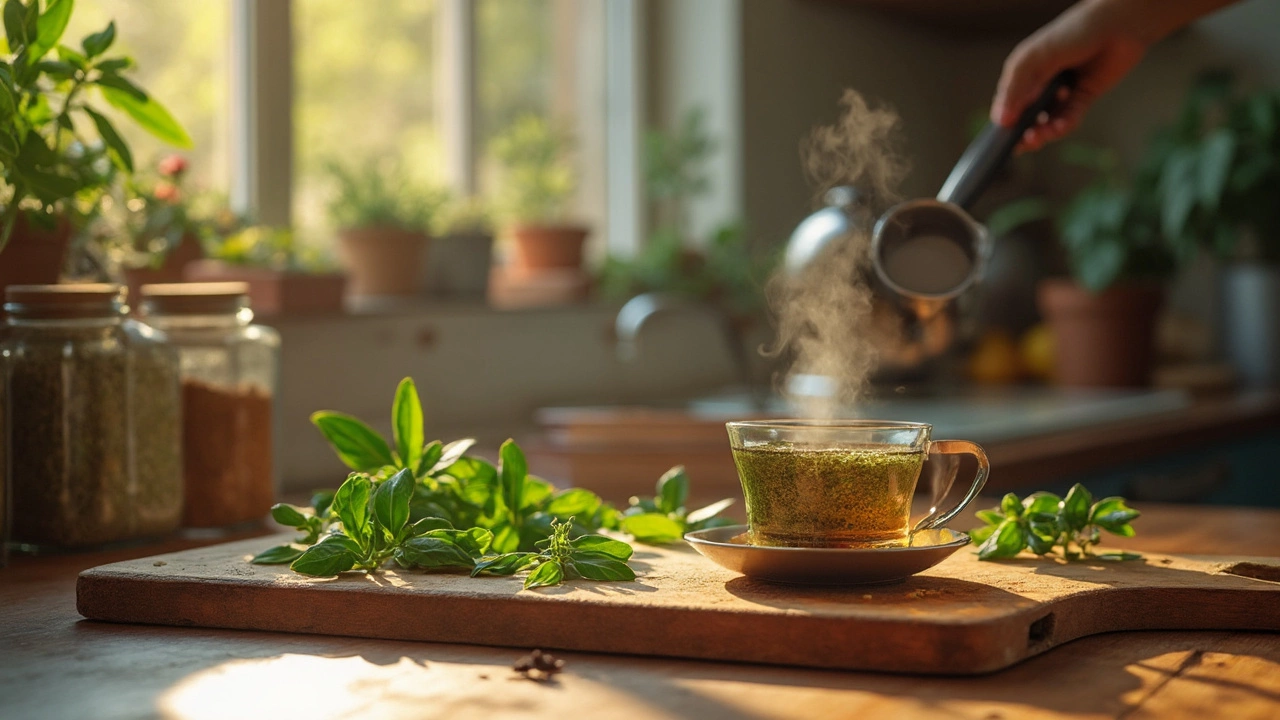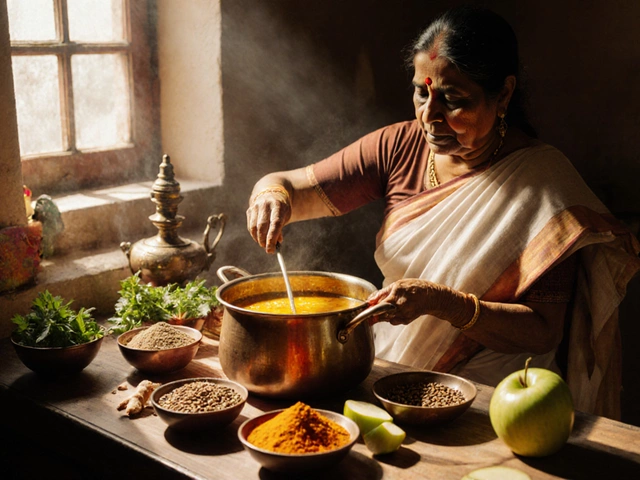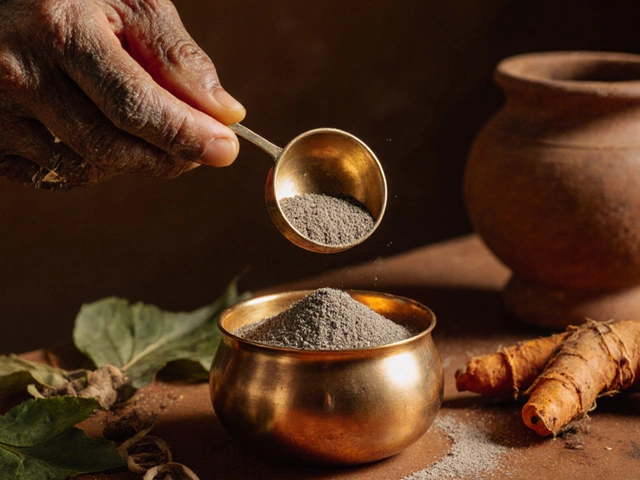You hear people raving about one plant above all others in Ayurvedic circles—Tulsi. This isn't just an old wives’ tale; Tulsi, or holy basil, is called the Queen of All Herbs for a reason. The title isn’t just for show—Tulsi’s reputation grew because it actually works. I’ve seen it in action, from my grandmother's home remedies to modern health shops selling tulsi teas and extracts everywhere.
If you’re trying to keep your immune system fired up or want a stress-busting routine that doesn’t involve a subscription box, tulsi is your simple answer. It’s incredibly practical—you can use the leaves fresh, brew them in tea, or even chew them straight off the plant. Even my dog Bruno sniffs out the tulsi patch in our yard! The best part? Tulsi fits easily into daily life, whether you live in a busy city or a small town with a few pots on the window sill.
- What Does 'Queen of All Herbs' Mean?
- Why Tulsi Deserves the Title
- Tulsi in Daily Life: Uses and Recipes
- Health Benefits Backed by Modern Science
- Choosing and Growing Tulsi
- Potential Side Effects and Precautions
What Does 'Queen of All Herbs' Mean?
The title 'Queen of All Herbs' isn’t given to just any plant. In the Ayurvedic world, it’s a big deal— reserved for something that stands out for its health benefits and how much you can actually use it. If you poke around Indian households, you’ll see a tulsi plant in courtyards or windows. This isn’t just for show. Tulsi’s been used in Ayurvedic medicine for more than 3,000 years, right up there with must-haves like turmeric and ginger.
Now, why the royal treatment for holy basil? It’s simple: versatility. People have turned to tulsi for everything from headaches to immune support. In old texts, it’s called a 'rasayana'—basically, something that keeps you fit, calm, and sharp in the mind. Latin name? Ocimum sanctum. But everyone just calls it tulsi.
This plant holds a place in Indian culture way beyond just medicine. Folks use it for prayers, in tea, and even as a natural air purifier at home. When experts call it the Queen of Herbs, they’re saying: hands down, it’s reliable for both daily and emergency health fixes.
- It can be eaten fresh, dried, or brewed in tea
- Works for digestive issues, colds, and even minor skin problems
- Loved by both traditional healers and modern health fans
In fact, one 2022 survey in India found that over 80% of families still keep a tulsi plant around, using it for minor health problems before heading to the pharmacy. It’s accessible, easy to grow, and proves itself in real life—making that Queen title pretty accurate.
Why Tulsi Deserves the Title
So, why is tulsi getting labeled the Queen of All Herbs? It’s not just because it sounds good in texts. The popularity boils down to how many ways this plant actually helps you out, according to both old-school Ayurveda and new science.
First off, tulsi (also called holy basil) is a natural fighter. In India, people have been using it for over 3,000 years to tackle coughs, colds, stomach bugs, and even headaches. There’s a big reason temples have tulsi plants at the entrance: it’s believed to keep you healthy and drive away bad vibes. And if you check Ayurveda texts, tulsi makes the top of almost every list for making the body more resilient against disease.
But don’t just take it from tradition. Several modern studies have shown that tulsi is rich in things called ‘adaptogens.’ These are natural helpers that make your body better at handling stress. One research paper from 2021 published in the Journal of Ayurveda and Integrative Medicine found participants who took tulsi extract felt less anxious and slept better.
| Benefit | Backing |
|---|---|
| Reduces Stre ss | Contains adaptogens (proven in human studies) |
| Boosts Immunity | Includes vitamin C, zinc, and antioxidants |
| Helps with Cough & Cold | Shows anti-microbial and anti-inflammatory effects |
Another thing that makes tulsi stand out? You can use almost every part—leaves, seeds, and even the stems have medicinal uses. So whether you’re pulling a leaf to pop in your chai or drying it for powder, you get decent mileage from a single plant.
Plus, holy basil is totally safe for most people. No need for a degree to figure out how to use it. Just eat it raw, brew it as tea, or drop a few leaves in your hot water. Even if you’re new to herbal stuff, tulsi makes it simple to get started.
- Tulsi grows easily in pots—no fancy gardening skills needed.
- Fresh or dried, it works just as well for teas and home remedies.
- Side effects are rare—as long as you don’t overdo it.
That’s why almost every Indian household, mine included, keeps a tulsi plant on the balcony or in the kitchen. There aren’t that many herbs you can count on for daily health and a quick immune boost. Tulsi actually lives up to the hype.
Tulsi in Daily Life: Uses and Recipes
If you think tulsi is only for temple rituals or old-school grandmas, you’re missing out. This herb works its magic in the kitchen and medicine cabinet both. No crazy prep required. People in India have tossed tulsi leaves into their tea or nibbled them straight off the plant for centuries—and not just for tradition. Here’s how you can bring the queen of herbs into your everyday routine, even if you’re not a DIY expert.
- Tulsi Tea: The easiest and most popular way. Boil 5-6 fresh leaves in a cup of water for about 3-5 minutes, strain, and sip. If you like, add ginger or a drop of honey for added kick. It tastes a bit peppery and minty and helps with congestion, sore throat, or just a sluggish afternoon.
- Chewing Fresh Leaves: Wash a few leaves and chew them raw. A lot of folks do this first thing in the morning for fresh breath and a mild energy boost. Just don’t go overboard—2–4 leaves a day is enough.
- Tulsi in Cooking: You can toss chopped tulsi leaves into salads, soups, or chutneys. The flavor’s bold, so start small and see what you like.
- Tulsi Face Packs: If your skin is freaking out, grind fresh leaves and mix them with a bit of aloe vera or honey. Spread it on your face, wash off in 10 minutes. It helps with acne and redness.
- Tulsi Oil: You can infuse oil for balms or massages by steeping dried leaves in coconut or olive oil for a few weeks. The oil smells good and can be soothing for skin irritations or scalp problems.
Fun fact—one study from Benares Hindu University suggested drinking holy basil tea daily helped lower stress markers in college students. You probably won’t turn into a Zen monk overnight, but it’s a nice, easy habit to build.
| Common Tulsi Uses | How Often |
|---|---|
| Tulsi tea | 1-2 cups per day |
| Chewing leaves | 2-4 leaves daily |
| In cooking | As desired |
| Face packs | 1-2 times a week |
| Tulsi oil | As needed |
If you have pets like my dog Bruno, skip giving them tulsi directly unless your vet says it’s cool. For humans, though, these uses are simple and actually doable. Once you start, tulsi becomes something you’ll want handy in your kitchen or your garden, not just in some fancy supplement jar.

Health Benefits Backed by Modern Science
Ask someone why Tulsi is everywhere in Ayurveda, and they'll tell you it "fixes everything." But what's really cool is that modern research backs a lot of these claims. Tulsi (or holy basil) isn’t just a religious or cultural thing—it’s studied, tested, and shown to actually help in real ways.
Let’s get into specifics. Researchers have found that Tulsi is loaded with antioxidants. These little guys help protect your cells from everyday stress, like pollution or junk food. Studies from Indian and international labs show that people drinking tulsi tea or taking tulsi extract had lower markers of stress and inflammation after just a couple of weeks.
If you’re interested in immunity (and who isn’t since 2020?), Tulsi stands out here too. It actually helps your body fight off viruses and bacteria. In one study from a university in Lucknow, folks who took tulsi daily caught fewer colds than those who didn’t.
| Benefit | What Science Says |
|---|---|
| Stress relief | Reduces cortisol and boosts mood |
| Immunity | Fewer colds, better white blood cell function |
| Blood sugar | Lowers fasting blood glucose in diabetics (as per 2012 Indian trial) |
| Antioxidants | Fights free radicals, limits cell damage |
Now, about diabetes—there was a 2012 trial where people with type 2 diabetes took tulsi leaf powder. Their morning blood sugar numbers went down, and some even needed less medication. Of course, don’t skip your meds, but adding tulsi can genuinely help.
If you’re after a natural way to lower stress, boost your immunity, or maybe keep blood sugar in check, tulsi does more than just sit pretty in holy water. Its legit health effects show why it truly deserves the title "Queen of All Herbs." And the best part? You don’t need fancy supplements—just fresh leaves or good-quality tulsi tea does the trick.
Choosing and Growing Tulsi
If you're new to tulsi, it helps to know there are a few main types: Rama (green leaves), Krishna (darker, almost purple), and Vana (wild, with a stronger aroma). Rama is the one most people grow at home, but Krishna and Vana are just as easy to find nowadays in good nurseries or herbal shops.
Picking a healthy plant is pretty straightforward. Look for bright, perky leaves, with no yellow patches or wilted edges. If you see black spots or droopiness, move on. Nurseries sometimes sell tulsi as "holy basil," so don’t get confused by the name.
Growing holy basil at home is simple—even if you have zero gardening skills. This plant practically thrives on neglect, which is great if you tend to forget to water your pots now and then. Here’s what works best:
- Plant tulsi in well-draining soil. Regular potting mix with a bit of compost does the trick.
- Give it a spot with at least 4-6 hours of sunlight. A sunny window or balcony is perfect.
- Water when the top of the soil feels dry. Overwatering is worse than letting it dry out for a day or two.
- Pinch off the flowers if you want bushier growth—this really helps.
- If you want the leaves for tea or remedies, pick them early in the morning for the best flavor and oils.
Tulsi adapts well in small pots (a regular 6-inch pot is fine), so even apartment dwellers can enjoy fresh holy basil year-round.
Here’s a quick look at what your basic tulsi care should look like through the year:
| Month | Care Tip |
|---|---|
| March - May | Best time to plant. Give extra water if it’s hot. |
| June - August | Watch out for bugs. Spray neem oil if you see tiny pests. |
| September - October | Harvest leaves before it gets too cold. |
| November - February | Move pots indoors if it’s freezing outside. |
If your tulsi plant suddenly looks sad, try moving it to a sunnier spot, or trim back any dried branches. Most of the time, it bounces back with a little care. Bonus tip: toss the dried leaves in your tea or even add them to pet water bowls (in small amounts, it’s safe—even Bruno benefits!).
Potential Side Effects and Precautions
It’s easy to think the tulsi hype means you can’t go wrong, but you still need to use your head. For most people, tulsi is totally safe and gentle when you stick to food-level amounts—think teas or the odd leaf in a salad. But there are a few things worth paying attention to if you're planning to go all-in.
If you have low blood sugar or take meds for diabetes, talk to your doctor before loading up on tulsi. Tulsi can lower blood sugar levels a bit more than some folks want. It also mildly thins the blood, so if you're on blood thinners or prepping for surgery, that’s another reason to double-check with a doctor first.
Pregnant and breastfeeding women might want to take it easy with tulsi. There aren’t a lot of big studies on how it affects pregnancy, so traditional advice is to skip high doses, just to play it safe. And if you’re allergic to plants in the mint family, watch out—reactions can happen, like with any herb.
- Holy basil could impact fertility in high doses (seen in some animal experiments).
- Kids should stick to small, food-like amounts unless a healthcare provider says otherwise.
- It may interact with certain medications, especially those for thyroid, blood sugar, or blood clotting.
If you notice a rash, tummy upset, or anything weird after adding tulsi to your routine, back off and check with your doctor. For most people though, especially at normal levels, tulsi is safe and easy to add to your daily lineup. It’s always best to listen to your body and never go overboard, even with the so-called queen of herbs.
| Group | Possible Concern | Advice |
|---|---|---|
| Pregnant women | Limited safety info | Avoid high doses |
| People on blood thinners | Possible thinning effect | Consult your doctor |
| Diabetics | May lower blood sugar | Monitor levels |
| Children | Lack of research | Stick to small amounts |





